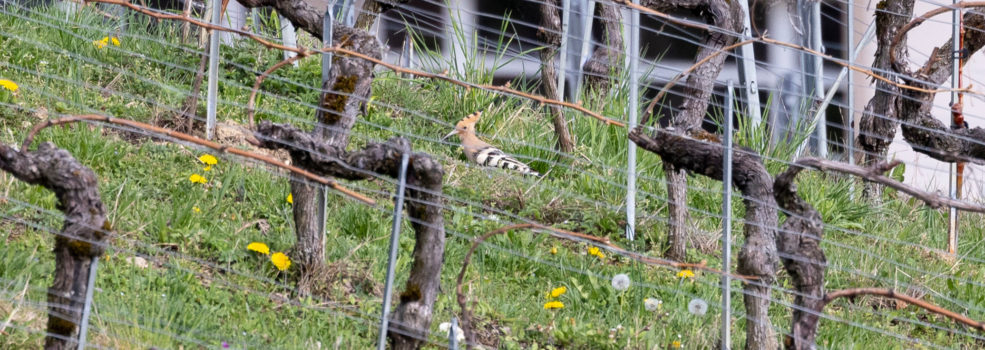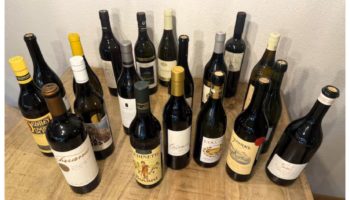
Great wine, the Hoopoe and Biodynamic agriculture
17 May 2022During our treks and customer events, we like to treat our guests with good wine and explain its origins. This offers opportunites to explore relationships between high quality local produce and biodiversity. Such conversations naturally flow into the fauna and flora observations one is more likely to enjoy in preserved land where economic imperatives are balanced with respect for nature. The Paccot family, owner of Domaine La Colombe in Féchy demonstrated that such efforts can find their reward. They gradually introduced biodynamic methods to their entire estate since 1999, pioneering on the topic in the region.
Common hoopoe on a vineyard between Rolle and Morges / Huppe faciée sur un vignoble entre Rolle et Morges
Meanwhile, fellow winemakers follow suit. And whilst the potential is huge with more to achieve, positive outcomes can be enjoyed by us mere mortals. First, Paccot’s (and his peers) wines are excellent and internationally recognised. Secondly, strolling through the vineyards above my hometown Rolle is becoming more enjoyable. Pesticides, albeit still in use are less common, grass is not systematically burnt out of vineyard rows and life is getting some chances: better soil quality, flora diversity typical for extensive agriculture land, insects, birds, toats, weasels, small rodents, etc. This diversity is essential, helps in bringing resilience to ecosystems that in turn give more place to life. More and more people are working towards that aim.
Black Redstart / Rougequeue noir (f)
Other conservation efforts such as favouring, e.g., mosiac landscapes (shrub, bushes & brambles, small forest patches) alongside the vineyards or in unexploitable ravines carved out by streams flowing from the Jura have contributed to this huge task. Such structures offer habitat, hideaways and food necessary to survive – and reproduce.
This is all observable on the terrain, and getting into the vineyards from Rolle is a question of minutes on an e-bike. So today seemed a good day to explore the “Birds & Wine” theme a bit further.
Krestel / Faucon crécerelle
Never afraid of unrealistic challenges, out I went with the humble goal to find the Common Hoopoe, one of the most beautiful – but rare – birds of Switzerland, classified “vulnerable” on the red list after having been present in the entire country in its better days. To be on the safe side, my fallback objective was to see how many species I’d be able to catch on camera in one afternoon.
CH:Presence of Common hoopoe / Présence de la Huppe fasciée
As it happened, towards the end of the day, whilst laboriously trying to get a sharp image of the Common Stonechat illustrated above, the Hoopoe made its appearance. Hardly believing my luck, I managed not to spoil this moment; the graal of the day awarded me with a nice pause (see title image), taking its time to decide where to land, probably to catch some juicy mole crickets for its nestlings.
Looking for food / En recherche de nourriture
Apart from this stroke of luck, most of my time has been dedicated to capture other winged creatures, with some nice – but I suppose not particularly surprising for my ornithologist friends and certainly incomplete – results.
Rolle castle serving as backdrop to an ash supporting Common linnets, Chaffinches, Goldfinches and European Serins / Chateau de Rolle servant de décor à un frêne portant Linottes mélodieuses, Pinsons des arbres, Chardonnerets élégants et Serin Cenis
I nevertheless have the immense pleasure to introduce some of the common members of the Aves species one can typically spot in the area.
Illustrated above:
- Mrs Black Redstart: always reassuring to meet spring after spring
- Common Stonechat (m), beautiful songbird, similar to its cousin the Whinchat who completely disappeared from the swiss plains after loosing its habitat, to find a precarious refugee in on higher less intensively exploited fields
- The Kestrel – seems less present in 2022 compared to 2021
Below:
- Mr and Mrs Common linnet, both freshly back from a bath still busy grooming up. What a joy to see this bird largely victim of the “cleanlyess obsessions” imposed on our landscapes
Further below not yet mentioned:
- European Serin – what an amazing sight each time
- Mr Black Redstart
- 4th picture: Chaffinch – most common bird in Switzerland
- Eurasian Buzzard, most thriving bird of prey
Eurasian Buzzard / Buse variable
In trees surrounding the vineyards,:
- Mr and Mrs Chaffinch
- The European greenfinch
- The Goldfinch (m, f)
- The Blue tit
- Black kite, ready to defend its nearby nest
To top an unspoilable day, I was able to get my first shot ever of a Wryneck. Far from perfect, I unshamely indulge in bragging about this shot of a bird that is not easy to spot.
Eurasian Wryneck / Torcol fourmilier
The past was certainly much richer when it comes to numbers, species variety and biodiversity quality in general, and lots of efforts remain. “Shifting baselines”, as explained by prominent Rewilding innovators such as Paul Jepson, remind us that our views are by definition biased by what we think to “be normal” based on how we experienced the world when we first met it.
Yet, encouraging signals deserve to be noted – and enjoyed shamelessly in the form of a great glass of, for example, Chasselas from the Domaine la Colombe.
Black Redstart / Rougequeue noir
Other species one would commonly hear / see nearby these vineyards:
- Green woodpecker / Pic vert
- Common crane / Grue cendrée
- Black-headed warbler / Fauvette à tête noire
- Eurasian Blackbird / Merle noir
- Red Kite / Milan royal
- etc.



